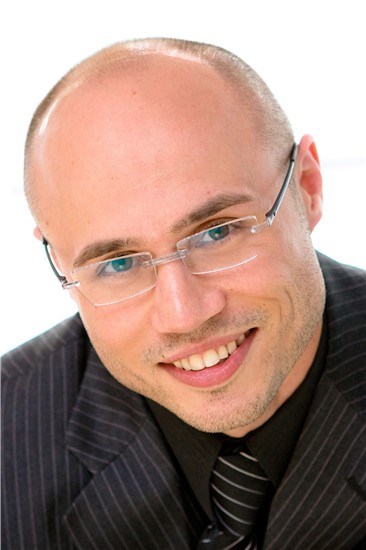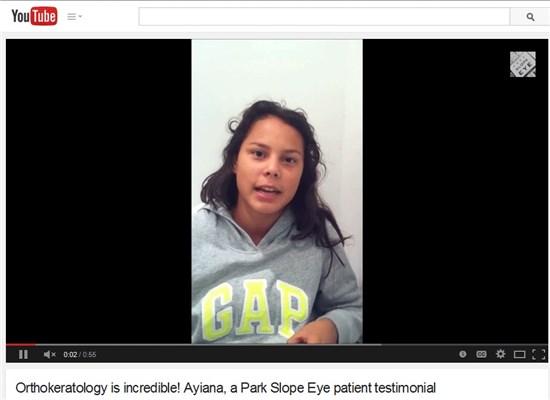By Justin Bazan, OD

February 4, 2015
SYNOPSIS
Orthokeratology (Ortho-K) is a practice-builder—if you educate your patients on the unique benefits you can provide.
ACTION POINTS
GAUGE NEED FOR ORTHO K. A patient base with families with children is ideal, as is a community that with a high enough income to support the $2,000 fee.
INVEST IN NEEDED INSTRUMENTATION. A quality topographer can be purchased for as little as $7,500, and can be used for Ortho K, in addition to patient needs.
EDUCATE PATIENTS. Be prepared for common questions like, how it works, whether it’s safe and whether it really works.
Orthokeratology (Ortho-K), in which a patient wears an oxygen-permeable contact lens overnight to temporarily reshape the cornea to sometimes allow them to be glasses- or contact lens-free during the day, is a potential practice-builder. Ortho-K, long-established but little known, offers new RGP designs and clinical research to improve the process, and has great appeal to parents with childrenexperiencing myopic creep. Here are the keys to making the most of this opportunity to offer a premium service and practice differentiator that generates happy patients and referrals.
I first offered this service in the fall of 2013, and this niche continues to grow in patients and revenues generated. Here is what I’ve learned along the way about getting started in this specialty area.
The first of my patients who opted for Ortho-K visited my office in September 2013. By design, I picked an ideal candidate, whose eyes could be impacted enough for them to be glasses and contact lens-free during the daytime, and it worked out to be very straightforward. The ideal patient for me is highly motivated and excited about Ortho-K, has no contraindications, and has an Rx in the -2 to -4 range. My children Ortho-K patients have proven to be easier to please than the adults. Also, their corneas respond faster to the molding–and they don’t complain about night driving because they aren’t driving yet! The process went mostly as planned and took the expected amount of chair time. My fee was $2,000, so I did well from a financial perspective. Once you develop your Ortho-K process, and it becomes routine, you will have an idea of how much time you will be spending with the patient. You will also have an idea of the cost of your materials, giving you an idea of what your break-even dollar value is. High volume, high fee is my goal!
Click HERE or the image above to view a video posted to YouTube by Park Slope Eye featuring a testimonial from one of Dr. Bazan’s Ortho-K patients. Dr. Bazan says it’s important to let prospective patients know about Ortho-K, and that your practice is the place to visit for it.
Gauge Need for OrthoK in Practice & Growth Opportunity
I realized quickly that my patient population wasn’t as ideal as I had hoped. My patient base of young professionals, 25-35 years old, is not ideal! Busy lives, inconsistent sleep schedules, high expectations, cost concerns and limited motivation have proven to be some of the biggest challenges we faced with this population.
I also realized that since the awareness of Ortho-K in the general public is so low, people are often hesitant. But even with all those challenges, we went from a couple of patients every few months in the first year, to one to two patients a month. The average fee for Ortho-K remains around $2,000. So, if you project out $4,000 per month for a year, you see the figure is close to an additional $50,000 annually.
Typically, I see patients for one year. I see them on the first day to instruct and watch them insert the lenses, the next morning, two weeks later, and then at the three-month, six- month and one-year marks. They are always welcome to contact me, though, to see if they need to come in. I learned that a lot of times the patient/parent just needs to be encouraged that things are going great, everything’s normal, and that vision will improve over time, and that I look forward to seeing them at the next regularly scheduled follow-up.
The needed chair time varies from practice to practice, but I schedule my Ortho-K patients for 30-minute visits. Follow-ups, in which everyone is happy, only take a few minutes, but I still play it safe and book them 30 minutes.
Build Pediatric Patient Base
We have added a pediatric optometrist, and are building up our pediatric population. One of the best motivating factors for Ortho-K is a parent’s concern for their children becoming “blind just like me.” More specifically, when a parent who is highly myopic, learns about Ortho-K’s ability to help control their child’s myopia, they become very interested. It has been my experience that the children are often less critical of the process than the parents, and tend to be easier to please. Part of doing Ortho-K is managing the parent’s expectations, too!
Educate Patients About Process and Likely Outcome
If a patient is in my office because they have done their research, or there as a referral, my job is pretty easy. They often are well informed. At that point, it just becomes a matter of reinforcing the positive, correct information they have and clearing up any misinformation. If a patient is not so well informed about Ortho-K, I go over the basics in the office during the consult and give them “homework.” I have a lot of curated content on our YouTube channel that I ask them to review. Most of my parents want to know: “Does it really work?” and “Is it safe?” During the consult, I make sure they understand the general answer to both of those questions is a qualified “yes.” I never make any promises, and give them a version of the expectations that is slightly less than what I expect. That way, they are pleasantly surprised by the results and their expectations are exceeded.
If the patient is asking these questions of my staff, they might say: “Dr. B is the expert. Those are great questions to ask him.” If prospective Ortho-K patients contact us via e-mail, our staff simply replies back including me on the e-mail, so I can answer the person’s questions directly.
Ortho-K Resources
American Academy of Orthokeratology & Myopia Control
European Academy of Orthokeratology
Vision By Design conference
Invest in Needed Instrumentation
I have found the most important things to have are a topographer and a fit kit. Quality topographers can be found for as little as $7,500. The most common instruments are either handheld or similar in size to a slit lamp. The topographer allows me to better understand how the cornea is being molded and provides me with insights as to what to adjust. The fitting kit that I most commonly work with is the size of a slightly longer, yet thinner, briefcase. We do an in-office trial in which the patient will experience wearing an Ortho-K lens.
Prepare Yourself to Serve Ortho-K Patients
I didn’t know what Ortho-K was when I graduated from optometry school back in 2004. It is now part of the curriculum, but the exposure to real patients is limited, at best, for the average student. By far, I have learned the most about Ortho-K by attending the Vision By Design conference. It is packed with people who love Ortho-K. Their passion is inspiring, and the education is first rate. Any doctor interested in doing Ortho-K should attend.
I also would recommend that interested ODs join the American Academy of Orthokeratology & Myopia Control. They have an active e-mail list, filled with passionate experts, who are constantly discussing new techniques, giving updates and providing help.
Market OrthoK
Ortho-K is something that an interested person will research. Where are they doing their research? Online! You need to be a relevant search result. We utilize social media to help achieve this. YouTube has proven to be a great platform. Several patients have also found us via commercial sites that provide info on Ortho-K and have a doctor finder feature.
We have also learned that in-office exposure is key. Every patient in our office watches a brief video about Ortho-K, regardless of whether they have seen it before. We feel that by building awareness, we are maximizing our chances of that person becoming interested themselves, spreading the word or generating a referral.
Justin Bazan, OD, Park Slope Eye, Brooklyn, NY, started his own practice cold. He speaks regularly on strategies for marketing your practice via social networks. Contact: dr.bazan@parkslopeeye.com






















